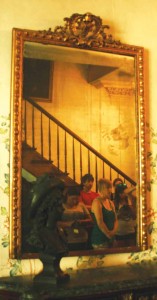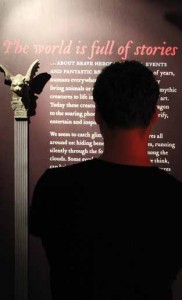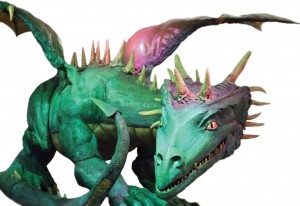An IU Southeast psychology course tackles the science behind ghosts, voodoo, and mythical creatures
By Erica Walsh
They do exist.
Or do they?
Be it ghosts, aliens, fairies, or dragons, there are a lot of things in this world that are hard to believe. But this summer, an IU Southeast psychology class set out to explore the unexplainable with a focus on parapsychology – or the study of interactions between living organisms and their external environment that seem to transcend the known physical laws of nature.
Assistant Professor of Psychology Lucinda Woodward didn’t necessarily want her class to prove the existence of such wonders, but rather to explore the science behind supernatural phenomena and question their role in the belief system of individuals.
Her students, like Drew Echelberger, a senior psychology major from Louisville, just wanted answers – but to what they weren’t quite sure.
“I wanted to give some explanation to what seemed to be unexplained,” Echelberger said.
Science, not spirits
This summer was the first time Woodward offered parapsychology as the focus of her applied research course. The class went beyond the paranormal and also included studies on voodoo, psychic readings, and mythological creatures.
Fourteen students signed up for the class, which included trips to the Mythical Creatures exhibit at the
Frazier History Museum in Louisville and reportedly haunted locations such as Waverly Hills Sanatorium in Louisville, The Whispers in Mitchell, Ind., and Bobby Mackey’s Nightclub in Cincinnati. The class culminated in a weeklong venture across the “haunted” South with stops in Durham, N.C., Savannah, Ga., and New Orleans.
The class was joined on the local trips by IU Southeast alumnus Brian Laythe, B.A. ’98, who holds a doctorate in psychology from the University of New Hampshire and is the founder of the Association for the Study of Anomalous Field Phenomena (ASAFP).
Laythe is not a ghost hunter but a field researcher.
“The unspoken rule in psychology is not to talk about parapsychology,” he said. “But we’re in this for the science. We empirically test claims of haunting or paranormal activity and complete field research that produces reliable scientific data.”
Basically, he doesn’t say that ghosts exist, just whether there is a scientific reason for the phenomena; and that’s what he wanted to teach Woodward’s students.
“We’re not teaching them to be a skeptic or a believer but to test,” he said.
At both The Whispers and Bobby Mackey’s, students were looking for electronic voice phenomena. They entered into a reportedly haunted environment, set up equipment designed to monitor sound waves, and asked a series of 40 freestyle response questions into the ether.
They discovered something, Laythe said, but the exact results of the study are still being evaluated by the ASAFP.
With electronic voice phenomena, the researchers attempt to debunk standard explanations for the noises by ruling out radio interference or contaminations. Formal research findings will be presented to the class at a later date.
The students also visited the Rhine Research Center at Duke University, which is the country’s preeminent academic research facility for parapsychology. According to its website, the center’s mission is to advance the science of parapsychology, to provide education and resources for the public, and to foster a community for individuals with personal and professional interest in “supposed parapsychological or psychic faculties or phenomena.”
The Rhine taught students how to evaluate unexplained phenomena without a bias and with a critical mindset.
“I loved the Rhine,” said Amy Basham, a senior psychology major from Madison, Ind. “We learned a lot and saw more of the scientific piece of the test.”

Students from IU Southeast’s paranormal psychology class reflected in a mirror during a tour of the Myrtles Plantation, which claims to be one of the most haunted locations in the country. Photo by Amy Basham.
That science allowed Basham to approach stops at a haunted hotel in Savannah and at Myrtles Plantation outside Baton Rouge, La., with a healthy skepticism. The antebellum plantation is reportedly home to at least 12 ghosts.
“Myrtles Plantation, it felt alive,” Basham said. “It’s hard not to believe some things when people say they’ve experienced it.”
What’s the answer?
Basham took the course because she’d always been interested in the paranormal, but she admits she also wanted to validate her belief that the paranormal exists.
“I really tried to be flat-lined at the beginning and keep my personal beliefs in the background,” she said.
It was difficult, she admits, but the scientific approach of the course helped her come to a more solid conclusion.
“It completely changed my beliefs in a way I was not expecting,” she said. “I believe in the power of the human mind now, not ghouls and ghosts.”
As Basham wandered around the Mythical Creatures exhibit at the Frazier History Museum in Louisville, she was presented with creatures like dragons, unicorns, Bigfoot, and mermaids. From her standpoint, it’s easier to think that spirits exist than that fantasy creatures once roamed the Earth. But the exhibit tied perfectly into what she took from the class.
“I think it speaks more for human culture and how the unknown was interpreted,” she said.
Other students in the class, like Sara Nieves, a senior psychology major from Seymour, Ind., came away with a different interpretation. Nieves had quite a few unexplained phenomena occur during the field trips.
“At Waverly Hills we heard a little boy talk to us; he said ‘Hi,’” she said. “Later in the trip, Lucinda’s car started all by itself. And we heard a ghost dog at Myrtles Plantation. We all heard it.”
Other class members believe they caught a ghostly figure on camera during a visit to Waverly Hills Sanatorium in Louisville. For Nieves, the empirical evidence they found at each tour stop was more than just hearsay or ghost stories.
“I already believed, and this class just reassured me that there really is more out there than you know,” she said.
For Woodward, the conflicting interpretations from her students were exactly what she hoped they would discover.
The course’s question was always open-ended. The answer, students found, was up to them.
“Spirituality and belief in the paranormal still have a lot of controversy,” Woodward said. “This class was a contrast in experiences. The reality truly is the creation of the individual.”




